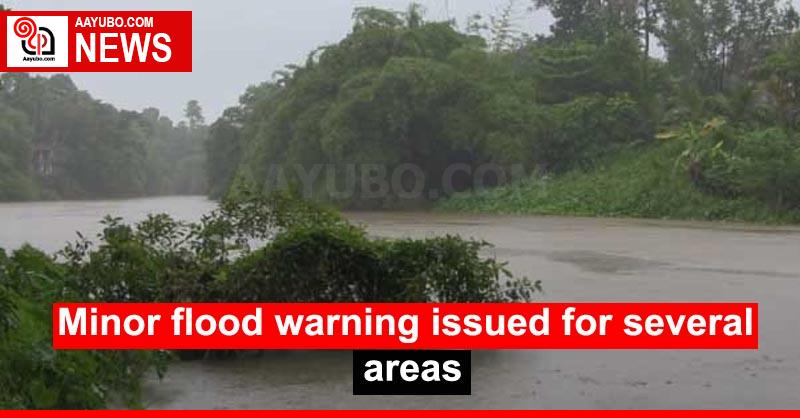Flood Warning Issued: Heed These Crucial Safety Precautions

Table of Contents
Understanding Flood Warnings and Alerts
Understanding the different types of flood warnings is crucial for effective response. The National Weather Service (NWS) issues various alerts, each signifying a different level of risk:
- Flood Watch: Conditions are favorable for flooding. Stay informed and be prepared to take action.
- Flood Warning: Flooding is occurring or is imminent. Take immediate action to protect yourself and your property.
- Flood Emergency: A severe and life-threatening flood is happening. Immediate evacuation is necessary.
These alerts are disseminated through various channels:
- How to Receive Alerts:
- Download a weather app from reputable sources like the NWS or AccuWeather. These apps provide real-time alerts and forecasts tailored to your location.
- Listen to local radio and television news broadcasts for weather updates and emergency announcements.
- Sign up for emergency alerts through your local government's website or emergency notification system. Many communities offer text and email alerts for severe weather events, including flood warnings.
- Understanding Terminology: Familiarize yourself with terms like "flash flood," "river flood," and "coastal flood," as each presents unique dangers and requires specific responses. Pay attention to the specific areas affected in the warning.
Staying informed and regularly monitoring weather forecasts, especially during periods of heavy rainfall, thunderstorms, or hurricanes, is vital for proactive flood preparedness.
Preparing for a Potential Flood
Proactive preparation is your best defense against flood damage. A well-defined plan minimizes risks and ensures your safety and the safety of your loved ones. Key preparation steps include:
- Family Emergency Plan: Establish a clear evacuation plan, identifying multiple escape routes and pre-determined meeting points. Practice your plan regularly.
- Household Inventory: Create a detailed inventory of your belongings, including photos and receipts, for insurance purposes. This will greatly speed up the claims process in the event of damage.
- Moving Valuable Items: Move important documents, photos, electronics, and other valuables to higher ground or a safe, waterproof storage location.
- Emergency Kit: Prepare an emergency kit containing essential supplies such as water, non-perishable food, a first-aid kit, flashlights, batteries, medications, and blankets.
- Flood Risk Assessment: Understand your specific flood risk. Check your local flood maps and consider your home's proximity to water bodies and historical flood data.
During a Flood: Essential Safety Measures
When a flood warning is issued, your safety is paramount. Prompt and decisive action is crucial.
- Evacuation: If instructed by authorities to evacuate, do so immediately. Don't delay; floodwaters can rise rapidly.
- Avoid Floodwaters: Never attempt to drive or walk through floodwaters. Even shallow water can conceal dangers like downed power lines, debris, and strong currents. Floodwaters are also frequently contaminated.
- Utility Shut-off: If it is safe to do so, turn off gas, electricity, and water supplies to prevent further damage.
- Seek Higher Ground/Shelter: Move to higher ground, a designated evacuation center, or a sturdy building.
- Stay Informed: Continue monitoring official channels for updates and instructions.
After the Flood: Recovery and Prevention
Returning to a flooded area requires caution. Post-flood safety and long-term prevention are critical.
- Structural Damage Check: Before re-entering your home, check for structural damage. A professional inspection may be necessary.
- Floodwater Contamination: Avoid contact with floodwaters due to the risk of contamination from sewage, chemicals, and other hazardous materials.
- Insurance and Authorities: Contact your insurance company to report damages and begin the claims process. Contact local authorities to report any safety hazards or damage.
- Flood Mitigation: Consider long-term flood mitigation strategies like elevating your home, installing flood barriers, or participating in community flood mitigation programs. These proactive measures reduce future flood risk.
Heed the flood warning and take preventative steps. Community involvement plays a significant role in preparedness; participating in local flood preparedness programs and sharing information helps everyone.
Conclusion:
Understanding and responding to flood warnings is critical. By taking proactive steps to prepare, staying safe during a flood event, and focusing on post-flood recovery, you significantly reduce the risk to life and property. Heed the flood warning, prepare for potential flooding, stay safe during a flood event, and take control of your flood safety. Create a flood preparedness plan today, sign up for flood alerts, and share this vital information with your family and community. Don't wait until it's too late; proactive flood safety saves lives and protects your future.

Featured Posts
-
 Architectures Crisis A Conversation On Virtue Signaling And Its Impact
May 26, 2025
Architectures Crisis A Conversation On Virtue Signaling And Its Impact
May 26, 2025 -
 Sarah Vine And The Dangers Of Casual Whats App Messaging
May 26, 2025
Sarah Vine And The Dangers Of Casual Whats App Messaging
May 26, 2025 -
 Flash Flood Warning Hampshire And Worcester Counties Thursday Night
May 26, 2025
Flash Flood Warning Hampshire And Worcester Counties Thursday Night
May 26, 2025 -
 Zoryana Fotosesiya Naomi Kempbell Vrazhaye Vidvertimi Obrazami
May 26, 2025
Zoryana Fotosesiya Naomi Kempbell Vrazhaye Vidvertimi Obrazami
May 26, 2025 -
 Box Office Boom 2005 Romance Film Reclaims Its Popularity
May 26, 2025
Box Office Boom 2005 Romance Film Reclaims Its Popularity
May 26, 2025
